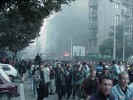"RACAK MASSACRE" - Perfectly staged trigger
The "trigger" was pulled on
January 16, 1999, when William Walker, the [US] Ad-ministration official assigned to
Kosovo with a team of observers from the Organization for Security and Cooperation in
Europe (OSCE), announced that a "massacre" of more than 40 ethnic Albanian
peasants by Serbian security personnel had taken place in the village of Račak. The
January 20 New York Times observed that the Ra č ak "massacre" followed
"a well-established pattern: Albanian guerillas in the Kosovo Liberation Army kill a
Serb policeman or two. Serb forces retaliate by flattening a village. This time they took
the lives of more than 40 ethnic Albanians, including many elderly and one child."
However, as the French newspaper Le Fi-garo reported on
the same day, there was ample reason to believe that Walker’s assessment of the
situation was made in "undue haste". Walker, the US official who headed a
700- man OSCE "verification" team monitoring a ceasefire in Kosovo, accused
Serbian police of conducting a massacre "in cold blood". According
to Le Figaro’s account, Serb policemen, after notifying both the media and
OSCE officials, conducted a raid on a KLA stronghold. After several hours of combat,
Serbian police announced that they had killed 10 KLA personnel and seized a large cache of
weapons. Journalists observed several OSCE officials talking with ethnic Albanian
villagers in an attempt to determine the casualty count.
"The scene of Albanian corpses in civilian clothes lined up in a ditch which would
shock the whole world was not discovered until the next morning, around 9am,"
reported the French newspaper. "At that time, the village was once again taken over
by armed [KLA] soldiers who led the foreign visitors, as soon as they arrived, toward the
supposed massacre site. Around noon, William Walker in person arrived and expressed his
indignation." All of the Albanian witnesses interviewed by the media and OSCE
observers on January 16 related the same version of events: namely, that Serbian police
had forced their way into homes, separated the women from the men, and dragged the men to
the hilltops to be unceremoniously executed.
The chief difficulty with this account, according to Le Figaro,
is that television footage taken during the January 15 battle in Racak "radically
contradict[s] that version. It was in fact an empty village that the police entered
in the morning ... The shooting was intense, as they were fired on from [KLA] trenches dug
into the hillside. The fighting intensified sharply on the hilltops above the
village." Rather than a pitiless attack on helpless villagers, the unedited film
depicts a firefight between police and encircled KLA guerillas, with the latter group
getting by far the worst of the engagement.
Further complicating things for the "official" account
is the fact that "journalists found only very few cartridges around the ditch where
the massacre supposedly took place".
"What really happened?" asks Le Figaro.
"During the night, could the [KLA] have gathered the bodies, in fact killed by Serb
bul-lets, to set up a scene of cold-blooded massacre?" Similar skepticism was
expressed by Le Monde, a publication whose editorial slant is decidedly
antagonistic to the Serbian side in any Balkan conflict.
"Isn`t the Racak massacre just too perfect?"
wondered Le Monde correspondent Christophe Chatelot in a January 21 dispatch from
Kosovo. Eyewitness accounts collected by Chatelot contradicted the now official
version of the "massacre", describing instead a pitched battle between police
and well-entrenched KLA fighters in a nearly abandoned village.
"How could the Serb police have gathered a group of men and
led them calmly toward the execution site while they were constantly under fire from [KLA]
fighters?" wrote Chatelot.
"How could the ditch located on the edge of Racak where the
massacre victims were later found" have escaped notice by local inhabitants familiar
with the surroundings who were present before night-fall? Or by the observers who were
present for over two hours in this tiny village? Why so few cartridges around the corpses,
so little blood in the hollow road where 23 people are supposed to have been shot at close
range with several bullets in the head? Rather, weren’t
the bodies of the Albanians killed in combat by the Serb police gathered into the ditch to
create a horror scene which was sure to have an appalling effect on public opinion?"
| 

